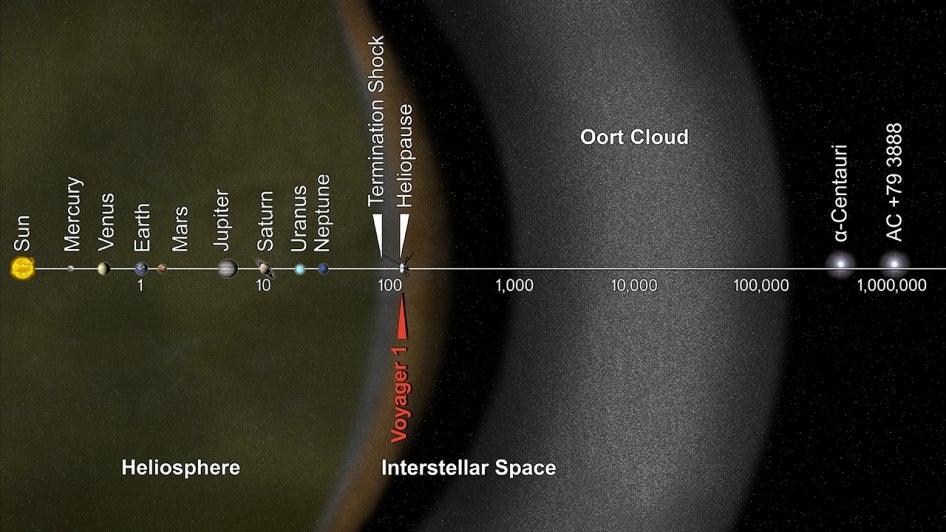Comet ISON 10 days out from one and only rendezvous with the sun
ListenAs Comet ISON heads towards the sun, its icy CO2 nucleus is beginning to sublimate, releasing the dust trapped since the nucleus first formed 4.5 to 5 billion years ago. While gravity pulls the comet towards the sun, it’s the blast of solar electromagnetic particles, the solar wind that pushes the dust out behind the comet creating the familiar tail. Because the pressure of the solar wind is always pushing outward from the sun, the dust particle tail of comets always points away from the sun. Right now, as the comet heads in toward the sun, the tail points away from the sun, trailing behind the nucleus. After the comet swings around behind the sun, heading back out into space, the comet’s tail will precede the nucleus, pointing its trajectory out of the solar system. The length of ISON’s tail will depend on how the nucleus is heated by the sun and how much material melts out of the nucleus as it passes the sun. ISON is now within reach of small telescopes, and will brighten to binocular visability.
November 18, 2013
[Dave Heller] A travel-tested comet created in the outer reaches of the solar system is now just ten days out from its first pass around the sun. Let’s hitch a ride with Derrick Pitts, chief astronomer at the Franklin Institute. Derrick, first and actually only pass pass around the sun?
[Derrick Pitts] Yeah, indeed. This particular comet is on an orbital path that will bring it into the center of the solar system for the first time. And then its trajectory will take it out again. So this is not a periodic comet, as many comets are known to be because we see them over and over again.
We’re talking about ISON and it was once tagged the “Comet of the Century!”
When it was discovered back in September of 2012, the thought was its passage by the sun and position relative to Earth were going to make it look spectacular! That was the great hope. Maybe it’s always the hope for comets that have similar trajectories. But as it turns out, Comet ISON hasn’t performed anywhere near up to that expectation. So it will certainly be an object that people can see, it just won’t look as spectacular as it was originally expected to.
What are the variables that shifted making it less attractive than once thought?
Well one of the thoughts is, what is its position in the sky relative to the Earth and relative to the sun? If only part of the comet is exposed to the sun, then that means that the solar wind won’t be able to melt as much material out of the comet, and thereby through solar wind create as big a tail and have much material to reflect off of so it will be bright in the sky. And that’s what looks like the situation with this comet.
-
Comet ISON is now approaching the inner solar system. Discovered last year, the comet remains unusually active for its distance from the sun. If current trends continue, ISON could rank as one of the brightest comets in decades when it makes its close approach to the sun in late November. This animation shows the comet’s approach and departure from the inner solar system from various perspectives. Credit: NASA’s Goddard Space Flight Center Scientific Visualization Studio
Point of review: A comet is a dirty snowball?
It really is just a dirty snowball. It is a frozen hunk of carbon dioxide that has dust, dirt, and rocky materials mixed into it from the early history of the solar system. So as frozen carbon dioxide, as it comes close to the sun and it begins to melt, it doesn’t have a liquid phase. It does what’s called sublimate, which means it goes directly from the solid right into a gas. And as it becomes this gas, it releases the dust particles that are then blown out by the solar wind from the sun that create the tail pointing away from the sun.
So this, unlike others that are periodic, is making a one-and-done approach with the sun. Will it then eventually be ejected out of the solar system?
Well that’s the way it looks right now. You have to remember that all of these objects that we would describe as “proto-comets” hang out in a region of the solar system called the Oort Cloud. This is the outer shell, the very farthest region of gravitational reach by the sun with any real strength. And as a passing object in space sort of dislodges them from the cloud they are then pulled by the sun in toward the center of the solar system. Now depending how they’re perturbed and how they’re pulled and what their mass is and other factors, that will determine whether they are periodic, meaning that they are on an elliptical course that brings them back around the sun over and over again no matter how big that elipse might be. And then there are these others that may be on what are called hyperbolic orbits, where the orbit is an elipse that isn’t closed and therefore come in and head out never to be seen again.
-

This artist’s concept puts solar system distances in perspective. The scale bar is in astronomical units, with each set distance beyond 1 AU representing 10 times the previous distance. One AU is the distance from the sun to the Earth, which is about 93 million miles or 150 million kilometers. Neptune, the most distant planet from the sun, is about 30 AU. Informally, the term “solar system” is often used to mean the space out to the last planet. Scientific consensus, however, says the solar system goes out to the Oort Cloud, the source of the comets that swing by our sun on long time scales. Beyond the outer edge of the Oort Cloud, the gravity of other stars begins to dominate that of the sun. The inner edge of the main part of the Oort Cloud could be as close as 1,000 AU from our sun. The outer edge is estimated to be around 100,000 AU. Credit: NASA
Is this one sufficiently perturbed that we can still see it?
[Laughs] It is perturbed enough that we can see it in the predawn sky. It’s now rising at about 4:30 and it rises about 12 minutes later every day. So by Friday, it will be rising almost an hour later. So rather than 4:30, you’ll see it at about 5:15 in the morning on Friday. It is brightening; it is a binocular object right now and it’s not far from the bright star Spica. So if you can locate Spica in the predawn sky, you can almost do a line from the regulus of real down to Mars and then onto Spica. This is a diagonal coming down to the left towards the horizon, and it’s about 20 degrees above the horizon. You’ll be able to identify the fuzzy patch with a short tail behind it with binoculars. Now, this is the pre-perihelion view of the comet. It may not look anywhere near as spectacular as expected, but it will be a good comparison view for what the comet will look like after it passes behind the sun on November 28.
Meanwhile, some saying there is a post-Halloween trick or treater masquerading as a comet.
Yes indeed, there is one. It is asteroid P2013P5 and this asteroid is displaying a lot of the same sort of outgassing characteristics as a comet might as it heats on its way in toward the center of the solar system. There are jets, actually six of them, that some have described as looking like tails of a comet and they’re at different angles coming out of the nucleus of this asteroid. And the question has been, what could possibly cause this? And the first thought was perhaps this is an asteroid that has been cased in ice and therefore as it melts coming in toward the center of the solar system, it’s creating these jets much like a comet does. But closer examination indicates instead that this is an asteroid that is really much more like a loose agglomeration of materials that make up the nucleus of the asteroid. So there are larger rocky boulder pieces, there are some smaller cobble pieces, and then there’s the dust sort of maybe holds it all together perhaps. So rather than being one sort of cemented batch, it sort of spread out a little bit more and the solar wind is blowing the dust off at different angles, creating what see as a tails.
Comet, check. Asteroid, got it. What else is available in the night sky this week?
In the evening sky right after sunset we can see without any difficulty at all Venus over in the southwestern sky by 8:30, 8:45. Jupiter is up in the eastern side of the sky and visible in the predawn sky beautifully along with Mars, Mercury (very low) and don’t forget Comet ISON is there also.
WHYY is your source for fact-based, in-depth journalism and information. As a nonprofit organization, we rely on financial support from readers like you. Please give today.




